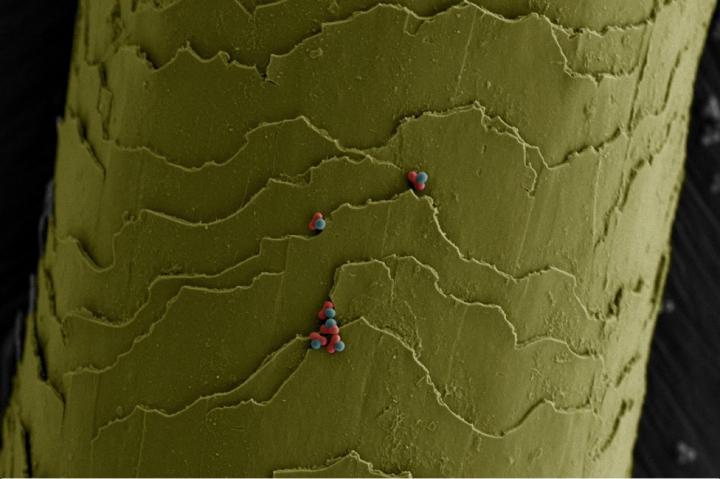Tiny transformers: Chemists create microscopic and malleable building blocks

A team of NYU chemists has created malleable and microscopic self-assembling particles that can serve as the next generation of building blocks in the creation of synthetic materials. The research focused on engineering particles a micrometer in width -- about 1/200th the width of a strand of human hair (on which the particles [pink and blue] are placed in the above image). Image courtesy of the Sacanna lab.
“Our work turns the tiniest of particles from inflexible, Lego-like pieces into ones that can transform themselves into a range of shapes,” explains Stefano Sacanna, an assistant professor in NYU's Department of Chemistry and the senior author of the paper, which appears in the journal Nature Communications. “With the ability to change their contours, these particles mimic alterations that occur in nature.”
The research focused on engineering particles a micrometer in width–about 1/200th the width of a strand of human hair.
Specifically, it aimed to enhance the adaptability of colloids–small particles suspended within a fluid medium. Such everyday items such as paint, milk, gelatin, glass, and porcelain are composed of colloidal dispersions, but it's their potential to control the flow of light that has scientists focused on creating exotic colloidal geometries.
By triggering specific morphological changes in the singular colloidal unit, the Sacanna group hopes to advance colloidal crystal engineering.
The scientists discovered that, much like Gulliver tied down by Lilliputians, metallic particles encased in oil droplets were tethered by many chemical bonds. Breaking those tethers via a photocatalytic reaction–in which the absorption of light spurs a chemical response–caused the metallic particle to free itself, producing an overall shape change. In other words, shining a light on a simple crystal allowed the scientists to create a material that transforms its microstructure.
###
The study's other authors were: Mena Youssef and Theodore Hueckel, both NYU doctoral students, and Gi-Ra Yi, a professor at South Korea's Sungkyunkwan University.
This work was supported by the MRSEC Program of the National Science Foundation (DMR-1420073).
Media Contact
All latest news from the category: Life Sciences and Chemistry
Articles and reports from the Life Sciences and chemistry area deal with applied and basic research into modern biology, chemistry and human medicine.
Valuable information can be found on a range of life sciences fields including bacteriology, biochemistry, bionics, bioinformatics, biophysics, biotechnology, genetics, geobotany, human biology, marine biology, microbiology, molecular biology, cellular biology, zoology, bioinorganic chemistry, microchemistry and environmental chemistry.
Newest articles

NASA: Mystery of life’s handedness deepens
The mystery of why life uses molecules with specific orientations has deepened with a NASA-funded discovery that RNA — a key molecule thought to have potentially held the instructions for…

What are the effects of historic lithium mining on water quality?
Study reveals low levels of common contaminants but high levels of other elements in waters associated with an abandoned lithium mine. Lithium ore and mining waste from a historic lithium…

Quantum-inspired design boosts efficiency of heat-to-electricity conversion
Rice engineers take unconventional route to improving thermophotovoltaic systems. Researchers at Rice University have found a new way to improve a key element of thermophotovoltaic (TPV) systems, which convert heat…



